New Jersey Future Blog
Accessing New Federal Funding for Active Transportation Projects: Camden County Got a Bunch, How Can You?
September 18th, 2023 by Zeke Weston
The Infrastructure Investment and Jobs Act (IIJA) was signed into law by President Joe Biden on November 15, 2021, investing $1.2 trillion in America’s infrastructure. From the IIJA, New Jersey municipal, county, and state governments have the opportunity to tap into once-in-a-generation funding programs, many of which support safe and accessible transportation alternatives for walkers, bikers and rollers. Camden County took advantage of the IIJA opportunity to secure $19 million in federal funding to design and build a new 3.8 mile section of the LINK trail. These new trail segments will connect existing trail segments from the Benjamin Franklin Bridge in Camden to Cooper River Park in Pennsauken.
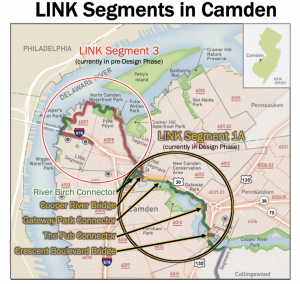
Camden City LINK Trail Map courtesy of the Bicycle Coalition of Greater Philadelphia
The Camden County LINK Trail is a 34-mile multi-use, off-road trail that, when completed, will connect 17 communities in Camden County and serve as the southeast section of the Circuit Trails Network in New Jersey. The LINK is part of a growing network of trail segments that are expected to eventually connect Philadelphia, PA to Cape May, NJ. Funding for the 3.8 mile Camden LINK was awarded from the Rebuilding American Infrastructure with Sustainability and Equity (RAISE), a discretionary grant program from the IIJA. RAISE grants can be used to invest in road, rail, transit or port projects, but Camden took advantage of it to expand their trail network, demonstrating that there are opportunities for active transportation projects to access funding.
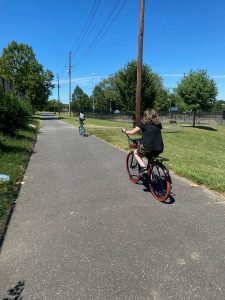
Two kids riding their bikes on an existing LINK Trail segment through East Camden
“Hundreds of people will be able to walk less than ten minutes to new public amenities,” explained Justin Dennis, Camden Program Director with the Trust for Public Land (TPL), on the importance of the Camden LINK. Many Camden residents will be able to walk or bike directly onto the LINK from their neighborhood. From there, the travel and recreation opportunities are vast and include access into downtown and numerous parks throughout the city. The safety of non-motorized users will be prioritized, so that residents can comfortably and safely rely on the trail network. Therefore, the Camden LINK Trail is not simply a recreational amenity, but more importantly an accessible and equitable regional connector. Dennis believes that the “LINK will improve the mental health and social cohesion of the community.” Project boosters hope the LINK Trail will be more than a leisure-oriented mixed-use path, and instead serve as an arterial transportation network for folks to get to and from their destination of choice without the need for or reliance on a car.
Felix Moulier, Project Manager for the Saint Joseph’s Carpenter Society, an East Camden non-profit that focuses on affordable housing and neighborhood development, grew up in Camden and recently moved back to live and work. The more Moulier learns about the LINK trail, the more he understands its value. “The trail’s influence on beautification is an instant win because it has an immediate impact,” he claimed. The creation of trail networks includes trees, flowers, benches and other components that alter the landscape of the community, in turn improving perception of the neighborhood among local residents and visitors. Households and individuals are anticipated to find green neighborhoods more welcoming to rent or buy property, or simply to enjoy local shops, museums, eateries, and other public amenities. Importantly, city residents will no longer have to travel out of their neighborhood to access public green spaces, improving the quality of life for the community. Thus, it serves as an example of how well-developed active transportation networks can positively influence communities in various ways, including providing reliable access to green and open spaces and connecting residents to their local waterway.
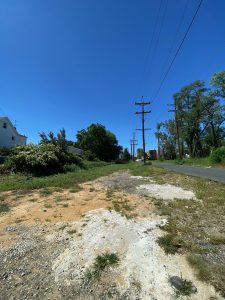

The picture on the left is of an undeveloped trail segment in East Camden, while the picture on the right is of a developed trail segment on the same road.
Francisco Moran, ex-Camden City Council President and Mayor, expressed that multi-use trail networks are “particularly important in a city like Camden, where one-third of the residents don’t own cars.” The new LINK Trail segments will better enable community members who don’t own cars or don’t want to drive, to travel around the city. Residents will not have to rely on cars to get around, rather they can walk or bike to their destination of choice. The lack of bicycle and pedestrian infrastructure in the city has been a major safety concern for folks attempting to get around without a car. The LINK will ensure pedestrians and cyclists have a safe and reliable route to travel through the city.


LINK Trail segment along the Delaware River in Camden
IIJA Funding Opportunities
The expanded grant opportunities provided by the IIJA, like the RAISE program that will fund the Camden LINK, will not last forever. IIJA funding is only available through fiscal year 2026 and the application process is extensive. Competitive projects often require feasibility studies, a planning and design process, and various other components that cannot be rushed. Therefore, the time to begin identifying and thinking about potential projects is now. In addition to RAISE, there are multiple IIJA programs that can be accessed for active transportation and complete streets initiatives. The Safe Streets and Roads for All competitive grant program funds Vision Zero initiatives that seek to make access and mobility safer for non-motorized users. The national $5 billion program can be used for active transportation projects that are likely to significantly reduce transportation related deaths and injuries. The Transportation Alternatives Set-Aside (TASA) is a program that has more than doubled in size under the IIJA that can be used for active and multimodal transportation projects, including bicycle and pedestrian facilities and complete streets. The process for applying to the IIJA programs begins long before the respective program deadline. Competitive applications include planning and feasibility studies to demonstrate project viability. This may require applicants to hire a consultant and is just one of numerous application requirements. Therefore, it is important to begin the planning process as soon as possible. Application costs may be covered by government agencies (see below), but even if not, they can unlock large grants. To gain a better understanding of the IIJA program and its potential uses, visit the State of NJ IIJA homepage. For help getting started on applying to the IIJA programs, visit your region’s Metropolitan Planning Organization’s (MPO) IIJA webpage: the Delaware Valley Regional Planning Commission (DVRPC), the North Jersey Transportation Planning Authority (NJTPA), or the South Jersey Transportation Planning Organization (SJTPO). Additionally, folks interested in learning more about how to access the active transportation opportunities in New Jersey can email NJDOT’s Office of Bicycle and Pedestrian Programs (BIKEPED dot
dot nj
nj gov) or the New Jersey Bicycle and Pedestrian Advisory Council (BPAC) (bikeped
gov) or the New Jersey Bicycle and Pedestrian Advisory Council (BPAC) (bikeped ejb
ejb rutgers
rutgers edu) for more information.
edu) for more information.
For help determining who to reach out to and how, feel free to email New Jersey Future’s Land Use Policy Coordinator, Zeke Weston (zweston njfuture
njfuture org) .
org) .
Creating Safe Communities and Options for Walk-Bike-Ride Transportation in New Jersey
August 8th, 2023 by Sneha Patel
“Every decision about transportation is an opportunity to build a clean, healthy, and more prosperous future,” declared Christopher Coes, Assistant Secretary, U.S. Department of Transportation (DOT) as he provided prepared remarks to open the session “Delivering Walk-Bike-Ride Transportation in New Jersey” at the 2023 Planning and Redevelopment Conference co-hosted by the NJ Chapter of the American Planning Association and New Jersey Future.
New Jersey has an exceptional opportunity in the transportation sector to expand walk-bike-ride options in many communities, especially in the face of the large increase in federal funding for transportation, and the unlimited discretion the state has for the use of these funds. The Bipartisan Infrastructure Act allowed DOT to award $1 billion dollars through Safe Streets to create safe corridors, and $4.5 million over the next five years to improve efficiency by providing more affordable public transit. The number of pedestrian fatalities has climbed to the highest levels since 1981, and during 2020-2022 more individuals died in rural, Black, and brown underserved communities, stressing the need for an infrastructure shift to prioritize safety. Crowded streets and large populations in urban neighborhoods can make pedestrians feel unsafe, and the lack of sidewalks along high-speed eight lane stroads in suburban neighborhoods elicit the same feeling. Emphasizing pedestrian safety and encouraging walk, bike, and ride options requires committed local leadership to seek and earn allocated resources and funding for their communities.
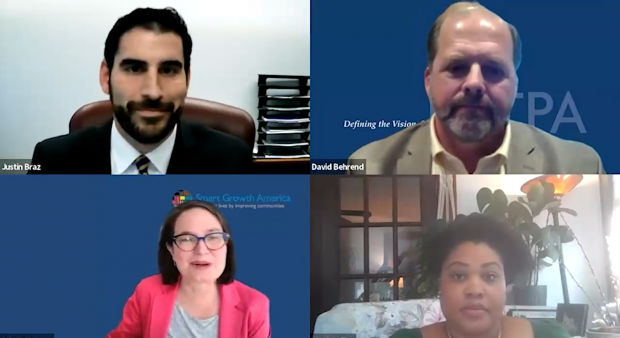
The virtual plenary Delivering Walk-Bike-Ride Transportation in New Jersey at the 2023 NJ Planning and Redevelopment Conference. Top from left to right: Justin Braz, Assistant Commissioner for Transportation Policy and Chief of Staff, New Jersey Department of Transportation; David Behrend, Executive Director, North Jersey Transportation Planning Authority (NJTPA). Bottom from left to right: Beth Osborne, Vice President for Transportation and Thriving Communities, Smart Growth America; Nicole Miller, Principal, MnM Consulting.
The session was moderated by Beth Osborne, Vice President for Transportation and Thriving Communities, Smart Growth America. Panelists offered their insights on the successes and challenges of implementation at the local level. They included: David Behrend, Executive Director, North Jersey Transportation Planning Authority (NJTPA); Justin Braz, Assistant Commissioner for Transportation Policy and Chief of Staff, New Jersey Department of Transportation; Nicole Miller, Principal MnM Consulting; and Christopher Coes Assistant Secretary, U.S. DOT.
Keynote speaker Christopher Coes described the federal government’s strategy for decarbonization and the ambitious goal of net zero carbon emissions nationwide by 2050. Transportation accounts for the major share of U.S greenhouse gas emissions, which is why the DOT, Environmental Protection Agency, and the Department of Housing and Energy have entered the first known memorandum of understanding (MOU) to decarbonize the transportation sector, releasing the U.S. National Blueprint for Transportation Decarbonization to assist states and communities. He stressed the importance of land use in increasing convenience for individuals through improved community design. Schools, job centers, and stores should be in proximity to each other to reduce commute burdens and expand opportunities for alternative transportation.

Keynote speaker Assistant Secretary Christopher Coes with the U.S. Department of Transportation during the virtual plenary at the 2023 NJ Planning and Redevelopment Conference.
Providing technical assistance to communities is necessary to achieve meaningful results. As part of the Thriving Communities cohort, East Orange has been selected as the first participant to receive hands-on technical assistance to connect the communities divided by I-280. Coes recognized that land use needs to be at the forefront of improving transportation infrastructure, adding that DOT provides developing tools and research to explain the connection between carbon emissions and land use to better inform their transportation policies.
“In the next 20 years, the Department of Transportation may be called the Department of Mobility,” Justin Braz mused. He noted increased funding and staff at NJDOT to liaise with communities and provide community members with multiple opportunities to move around. Increasing bikeways and trails and improving sidewalks are crucial to creating livable walkable communities. Braz highlights the seriousness of pedestrian safety and their focus at NJDOT on highway safety. He noted the initial data for 2023 for NJ has been positive; as of June 2023 the fatality rate is down 22% which is an improvement, but conceded “one death is one too many.”
David Behrend described the shift in federal funds from highway to public transit, such as electrifying bus fleets and transit improvements. He explained, “Everyone is rowing in the same direction right now, we want to take advantage of it when we can.” The North Jersey Transportation Planning Authority (NJTPA) aims to create the first-ever regional active transportation plan to improve bike and pedestrian mobility and safety. Behrend pointed out the need for “low-stress facilities,” where pedestrians feel it’s safe and convenient to walk, bike, or ride without the high traffic of cars. One key project Behrend emphasized was developing pathways like the Morris Canal Greenway, a 111-mile historic route cutting across the state from the Delaware River to Hudson County and connecting six counties. Behrend noted, “with Infrastructure Investment and Jobs Act (IIJA) funding, all the existing programs have gotten a degree of additional funding which …allows for more and larger projects.”
“Land use is key, but only comes after an internalized shift,” Nicole Miller declared, speaking on the difficulties of engaging people in slow-moving transportation improvement efforts and the potential rejection of such radical change. A perspective shift can be difficult when the ideal concept of the “American Dream” pressures households into single-family homes with two-car garages. She expressed “car-centric design has eroded urban centers, engrained a reliance on vehicles, promoted less-efficient energy and land-use, and unhealthily tied our economy to fossil fuels.” The cost of transforming the transportation sector cannot be ignored, she admitted, but “that cost must be measured against the lives lost, increased emissions produced, inefficient energy and land use, fewer housing options, and health concerns.”
With the shifting culture and more complex challenges of today, programs that weren’t created for the present ideology have to evolve. Braz described reshifting priorities to focus on long-term plans and the importance of committing to a full Complete Green Streets policy, with priority granted to projects that can be completed in two to three years.
Regional and local leaders should have a detailed plan that identifies specific needs to take advantage of existing funds. Behrend highlighted the NJTPA’s local demonstration project library for communities to access materials to test a temporary project setup and survey their impact. Braz reminded viewers not to overlook the value in targeting areas that only require minute fixes to address concerns like broken streetlights or weathered roads, in turn building community support behind quick improvements.
Shifting the attention towards public transportation can be done by involving community members, increasing public transportation options, and adding cost-friendly electric vehicles for younger people. Spreading awareness that increasing highway width does not decrease congestion, rather it only induces further demand and begets greater congestion. Cars have to be the most burdensome option, and walk-bike-ride should be better, cheaper, and faster Nicole Miller asserted. She continued that taking the train to work and entertainment centers “are sacrifices that people have to make, and part of the problem is we need a revised vision to make radical change.”
Rethinking Colonial Narratives and Transforming Native Insight into Actions: Indigenous Preservation of History
July 20th, 2023 by Sneha Patel
“Lenape means ‘the original human’, and that is where we need to get back to,” Chief Vincent Mann expressed, adding, “[reconnecting with the land] would provide us a way to encourage the people of tomorrow to take what we are sacrificing to create for them to further the future.” Indigenous people have a rich history of interacting in harmony with the environment. Colonialism commodified nature and continues to overshadow the indigenous history that existed in the Hudson Bay, and severed modern society from the ways of life that sustained pre-colonial populations. Panelists at a session dedicated to the subject at the 2023 Planning and Redevelopment Conference suggested creating a cultural interpretation center that preserves native history, through immersive teaching and community formation, as the start of a new strategy in facing a changing climate, while providing historical context on the Hudson Bay estuary and its ecosystem.
Moderated by Nagisa Manabe, Director of Development, Ramapough Culture and Land Foundation. The 2023 Planning and Redevelopment Conference session “Challenge Established Colonial Narratives of this Region’s History and Transform How We Communicate and Preserve indigenous History” recollected the painful past of native people that lived in the Hudson Bay area, and the importance of rewriting colonial history to disclose indigenous truths. The speakers Kerry Hardy, Historian, Lead Researcher and Cartographer at the Public History Project; Jack Tchen, Professor and Director, Clement Price Institute of Rutgers University Newark; Vincent Mann, Chief, The Turtle Clan of the Ramapough Lenape Nation; discussed the important role New Jersey indigenous communities can play in our region’s development and ensuring a resilient and equitable New Jersey.

Kerry Hardy, Historian, Lead Researcher and Cartographer at the Public History Project, speaking about the Hudson Bay and oyster bank during the virtual session, Challenge Established Colonial Narratives of this Region’s History and Transform How We Communicate and Preserve indigenous History, at the 2023 NJ Planning and Redevelopment Conference.
The Hudson Bay area was a natural source for oyster, clam, fish, and waterfowl resources that provided enough protein to sustain humans through the winter season. Native groups, such as the Munsee/Mohican, Hackensack, Raritank, Assunpink, Lechauwitank, and Minisink, navigated the Minisink Path 100 miles or more to the mouth of the Hudson River. Cheesequake, at the mouth of the Hudson, became a mecca and gathering site for native populations, where ceremonial council fires were held. Today, massive shell deposits hint at Cheesequake being once a major social center in indigenous life.
New Jersey’s estuary and tributary rivers, such as the Passaic and Hackensack River, previously held a seven mile wide oyster bank. Colonization spurred the conversion of wampum shells into currency for fur trade. Jack Tchen reflected “During this brief period of time we go from millennial uses of the bioregion as a cultural, food, and lifeways commons, to settler colonialism by turning natural resources of the region into a commodity marketplace.” Genocide and industrialization have left the original oyster bank largely devoid of natural resources and buried under a defunct railyard. Today, approximately half of the original oyster bank is covered by Liberty State Park.

Vincent Mann, Chief, The Turtle Clan of the Ramapough Lenape Nation, speaking during the 2023 NJ Planning and Redevelopment Conference with image of Liberty Park spanning approximately half of the original oyster bank.
Chief Mann remarked on the way that land and people hold the suffering of the violence that took place. The land that once forced migration of indigenous people became the entry point for millions of immigrants into the United States of America. “When you look at the Liberty State Park, it is not just the destruction you see, but the ability to replant the seed. To have that seed be something that can prosper and benefit all of humanity by telling the story of this land prior to contact, and telling the story of enslavement,” Chief Mann reflected.
Chief Mann proposes a cultural interpretive center to recount the history of America before it became the United States, suggesting the center would expose visitors to the parts of history that have been erased, and pave the way for an unprecedented reconnection to nature. Tchen explained the intimate knowledge of native people can demonstrate ways to work in harmony with nature to “rewild and protect the region, so that we have hope for the future and not have to build high walls to keep the ocean away or drain the rainstorms that are hitting us.”
Indigenous people, principally members of Lenni-Lenape tribes, are reasserting their ties to the environment, and reclaiming the shoreline to reseed oyster beds for future generations. “What you call climate change, I call human change,” Chief Mann expressed. He imagines the Liberty State Park interpretive center as a multicultural hub to preserve and spread knowledge about the proper way to treat nature, providing a travel destination for people to deeply interact with nature. He commented “we could create trail centers…, wild medicinal gardens, and ceremonial stone landscapes to educate people.” Knowledge would become a form of protection to keep hiking trails, like the Appalachian, untouched and clean.
“Colonialism isn’t just the domination of the Dutch or the British over the people…but it’s also about colonizing nature itself,” Tchen remarked. “This vision is also about how the park is a portal in which another way of life is revived.” Interpretive centers are crucial in showing what culture is still alive and showing the knowledge that the indigenous people have that has been recognized by scientists. While the world operates in colonial thought, Chief Mann believes that if they can collaborate with scientists on alternate opportunities that native people follow, they can inspire future generations to view nature differently. He explained, “we are planting the human seed of thought and all of those things need to be nurtured.” Chief Mann concluded the session with inspiring comments for the future. “The sun is always shining somewhere…There is always hope for tomorrow, and our hope is to see that in tomorrow’s people.”
With Recession in the Forecast, How Prepared is NJ’s Economy for Upcoming Rain?
July 20th, 2023 by Michael Atkins

Jeffrey Otteau, Managing Partner & Chief Economist, Otteau Group Inc.
As the world slowly but surely emerges from the challenges of the COVID-19 pandemic, all of us are evaluating the new parameters of our state and national economies that have experienced stimulus spending, historic inflation, supply chain disruptions, and high interest rates all in quick succession. Despite this emergence, the complete upheaval of labor, housing, and consumer markets has not meant all the pieces have returned to where they once were pre-2020.
Economist Jeff Otteau provided an in-depth analysis of NJ’s economic outlook in the months and years ahead, as well as an examination of these structural forces and their implications for real estate demand patterns in his keynote session, “Inflation, Interest Rates, and Indicators of NJ’s Post-Pandemic Economy”, at this year’s Planning and Redevelopment Conference, co-hosted by New Jersey Future and the American Planning Association NJ Chapter.
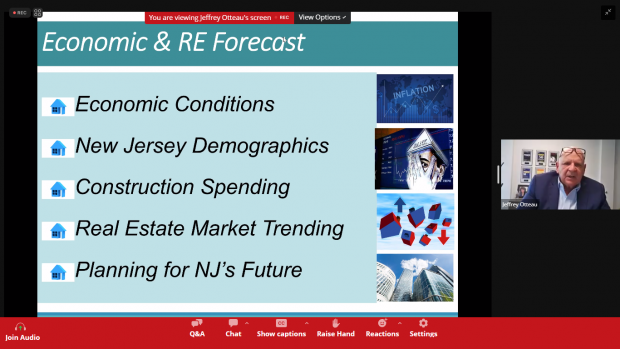
Jeffrey Otteau, Managing Partner & Chief Economist, Otteau Group Inc., speaking during his keynote session, Inflation, Interest Rates, and Indicators of NJ’s Post-Pandemic Economy, at the 2023 NJ Planning and Redevelopment Conference.
What’s Happening in the Economy?
The aftereffects of the pandemic were broadly favorable to New Jersey’s demographic and economic profile, as migration from New York City resulted in increased demand for real estate and steady job creation has returned employment to pre-pandemic levels. More recently however, the combined effects of elevated inflation and interest rates have set the stage for a reset in 2023 as the Federal Reserve Bank attempts to navigate a soft landing for the economy. “Real estate markets [will] enter a correction phase, with the [Federal Reserve] doing its level best to get that to happen. Expectation is that sometime in the near term the Fed will go through a correction phase in the NJ economy,” Otteau explained.
Otteau linked the speedy recovery of jobs to wage growth and price inflation. “We have not only recovered all the jobs we lost [due to pandemic downsizing], both locally and nationally, than we had pre-pandemic…We are up 4 million jobs nationally and 100,000 jobs here in NJ. With so many people working and collecting wages, it creates more income for spending, which feeds into inflation.” Other contributing factors to inflation include government stimulus, however much of that has been spent and accounted for, with today’s inflation most likely caused by the tailwinds of the aforementioned increase in employment. The Federal Reserve has made it abundantly clear their target for inflation is less than 2%, a goal we have not yet reached. As Otteau notes, “Inflation peaked last summer at 9% and has trailed back down to a 4% level. This has happened principally by the Federal Reserve increasing interest rates, which has slowed spending due to increased borrowing rates.” A cycle of rising interest rates is expected to lead to the contraction of the economy (nationally) by 1-2 million jobs, triggered by firms earning less profit on their enterprises due to increased borrowing costs, and ultimately a decline in consumer spending, which will aid in cutting inflation.
Another indicator Otteau examined in his plenary was the rate of construction inflation costs in NJ— both North and South Jersey experienced peaks of 17% and 20% cost increase respectively, with both brought down to approximately 3%, due to increased interest rates. (It should be noted this only means the increase in costs has slowed down, and construction costs overall have not reduced.) Rising costs of construction indicate increased costs to developers to build housing in NJ and maintain profitability, as real wages (essentially capacity for renters or buyers to meet increased rental or purchase costs) has lagged behind inflation. Home prices have remained elevated, and continue to rise, while commercial real estate is still recovering from a 40% decline in transaction volume.
While inflation has driven up costs on borrowing and developing housing, inflation has dramatically hurt American consumers. The cost of goods and services that wages are spent on, has continually outpaced real wage increases. Paychecks, which exceeded inflation in early 2021, have not kept pace with inflation throughout all of 2022, with the gap only now beginning to close. “American consumers have responded by putting these costs on their credit cards. We now have the highest amount of credit card debt in our history, and we’re also seeing a rise in delinquency rates among credit card consumers.” This is likely to lead to credit issues and defaults in an anticipated economic downturn.
“We are likely headed for a recession later this year. Banks have taken extraordinary measures to tighten their lending stances,’ Otteau explained in preparing for rainy days ahead. The mismatch between inflation and salary increases and the pivot to credit cards to cover that gap has led to a dramatic reduction in saving rates and totals among American consumers who are running out of savings, another event that typically predicts an economic downturn or recession.
This has not translated into increased delinquency rates among NJ mortgages, with only about 1 out of every 100 homes in NJ missing three or more mortgage payments. These rates are lower than the incredibly low delinquency rate at the start of 2020 (pre-pandemic) and are wildly lower than peak delinquency rates (approximately 12%) in the wake of the 2008 Great Recession. Otteau indicates that these low observed delinquency rates can forecast a “shallow” and “short” reset in the anticipated recession.
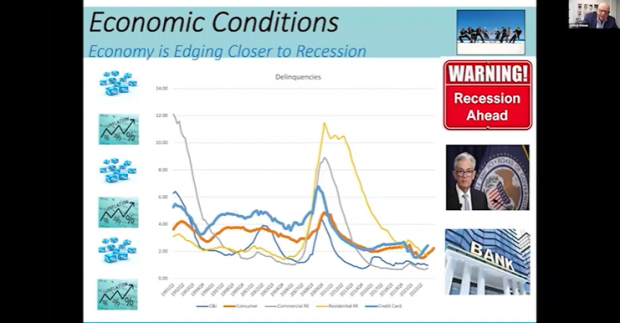
Jeffrey Otteau, Managing Partner & Chief Economist, Otteau Group Inc., speaking during the 2023 NJ Planning and Redevelopment Conference about predicted economic conditions.
NJ Demographics
While demographic data can lag up to 2 years behind other observed trends, they still provide information in analyzing our state economy and outlook. NJ remains an outbound migration state, with 2 out of 3 people leaving NJ for a reason other than retirement, according to a United Van Lines survey of their customers. “Half of everyone who is leaving can afford to stay here in NJ…with an income in excess of $150,000. This is something we need to give attention to and think about what can be done to reduce this outflow. Nothing good comes from residents leaving by choice who are high income earners in a state,” Otteau cautioned. NJ’s current net migration rate of -49,000 people is less than the pre-pandemic peaks in the -70,000 net migration rates. “We had 91,000 people move from NY to NJ. These people were putting distance between themselves and highly densely populated areas to reduce their risk of exposure to vectors of covid transmission, rising crime rates in NYC, and taking advantage of employer policies permitting remote work.” It will be important for economists, policymakers, and researchers to keep a close eye on demographics and population data in the coming years as we continue to track the effects of the pandemic and discern temporary from permanent impacts to real estate and labor markets, and our state and national economies.
Additional alarming indicators of NJ’s economic outlook include a demographic cliff of the composition and size of households. NJ continues to hemorrhage young adults and is seeing a decline in population “under 20”. These two population segments are incredibly crucial to future economic predictions; the 24-40 year cohort represent today’s most in-demand members of the workforce, the drivers of consumer spending, and the people who will purchase and form households, engaging in the 20+ year spending habits associated with forming a family. NJ is also seeing a reduction in population under 20 years of age, which will translate into contraction of this crucial block of spenders in the 2040s.
Housing Costs and Construction Spending
The number of home sales in the Garden State has declined for 24 consecutive months, which has reversed the pandemic bump that made NJ an attractive destination to NYC households moving from the city. “Post Service reported that 500,000 NYC households filed a change of address form, with NJ being a very large beneficiary.” Home sales have declined about 40% over the past two years, in a correction phase following the pandemic. One factor is the low inventory of houses on the market — currently NJ has approximately half the available houses on the market versus pre-pandemic levels, in part due to current homeowners not wanting to relinquish favorable interest rates, keeping “trade up” buyers on the sidelines. The rental market is also showing indicators of tough economic conditions for renters. With the median apartment rental cost in NJ clocking in around $2100 / month, senior rental housing is more costly than the median, indicating a very hot market for senior rentals throughout the state. Commercial spaces also forecast a bleak picture as approximately 3 million square feet of commercial spaces in NJ have gone dark in the past year.
2022 was a bounce back year for construction spending from the decline of the pandemic, with increases in Single Family and Multi-Family Household constructions, which have rocketed to over 200% increase with over $500 million dollars spent in the first quarter of 2023 on multi-family housing. Commercial and industrial construction have contracted slightly, largely attributable to the increased costs of goods and services due to inflation. The elevated pressures of inflation is likely to cool the spike in construction spending in the residential sectors.
Outlook Ahead
“Technology cuts both ways. While technology can be exciting, it is also a big threat.” Otteau cited an Oxford Study that predicts 47% of all US jobs to be lost to artificial intelligence. Data Centers are expected to quickly come into high demand to process all of the data as technology advances and integrates even further into our economic activities, similarly the telehealth economy is expected to continue to grow, as healthcare can be provided to patients remotely. This automation push, in tandem with increased interest rates, predicts a rise in unemployment in NJ and nationality in 2023.
Otteau concluded with cautious optimism, and pointed toward public policy solutions needed to respond to broader national economic pressures. “We live in one of the most prosperous places in the country, and therefore one of the most prosperous places on the planet. We have a highly educated population and a high quality of life. We are facing economic pressures and stressors in the next 12 months, which should be short and shallow in their recession effects, with a rebound expected sometime in the next year. We have a lot of work to create a place for people and employers to locate to ensure our future prosperity.”
Promoting Integration at the Local Level
July 20th, 2023 by Tim Evans
While New Jersey is one of the most diverse states in the nation at the macro level, at the local level it is also one of the most segregated. The state has grown more demographically diverse over the last two decades, but most of its individual towns and neighborhoods are either predominantly white or predominantly non-white, with few places occupying the “diverse” range in between. What can leaders do to promote more stable integration, so that towns can remain in the “diverse” space for the long term, rather than just momentarily passing through as part of a transition from one extreme to another?
Panelists in the session on “Promoting Integration at the Local Level” at the 2023 Planning and Redevelopment Conference offered insights to promoting diversity at the municipal level. Jessica Rafeh, Committeewoman and former Mayor of Pennsauken Township; Michele Alonso, Director of Planning and Redevelopment for the City of Asbury Park; and the session’s moderator, Nancy Gagnier, the Executive Director of the South Orange/Maplewood Community Coalition on Race talked about their experiences at the local level, while Jeffrey Perlman, Senior Director of Planning at the North Jersey Transportation Planning Authority (NJTPA), provided a regional perspective.

The virtual session Promoting Integration at the Local Level at the 2023 NJ Planning and Redevelopment Conference. Top row from left to right: Nancy Gagnier, Executive Director, South Orange/Maplewood Community Coalition on Race; Michele Alonso, Director of Planning and Redevelopment, City of Asbury Park. Bottom row from left to right: Jessica Rafeh, Committeewoman and former Mayor, Pennsauken Township; Jeffrey Perlman, Senior Director of Planning, North Jersey Transportation Planning Authority (NJTPA).
At the local level, a big part of promoting economic diversity means making sure there are housing options for households of all income levels, which requires local zoning that permits a diversity of housing types. Rafeh specifically mentioned Pennsauken’s broad range of housing types, and that the township is one of the rare suburban towns that already exceeds its Mount Laurel obligation for lower-income units. Alonso talked about the benefits of inclusionary zoning ordinances, noting that Asbury Park’s ordinances require new developments to be 20% affordable to be eligible for density bonuses. She also pointed out that redevelopment plans negotiated with developers offer an opportunity for towns to encourage a range of housing options: “Redevelopment agreements are an important tool that towns can use to make sure new developments are as economically inclusive as possible.”
Gagnier described South Orange/Maplewood’s first-time homebuyers loan program that is targeted at racial minorities to help them move into town, or to help existing renters graduate to homeownership. “Towns need to pay attention to changing demographics if they want to foster or preserve integration, so they can take steps to stay ahead of the changes,” she said. Achieving stable integration means towns must stay engaged as development patterns and housing markets change.
As a counterpart to programs and policies designed to help new residents move in, local leaders can also take steps to allow existing residents to stay in town when revitalization puts upward pressure on home prices, so that towns don’t become “victims of their own success” (a term cited by both Gagnier and Alonso as being a concern in their towns). Alonso said that Asbury Park recently adopted rent control as a way to guard against displacement of long-time residents, allowing them to participate in the benefits of revitalization when it happens. For homeowners, both Rafeh and Gagnier talked about local programs to help people finance home repairs.
Gagnier observed that while the percent of New Jersey’s population living in mixed-race neighborhoods has gone up in recent decades, “we still in many ways experience our lives in what feel like separate, segregated existences.” Maintaining good public spaces is one technique local officials can undertake to ensure mixed-race and mixed-income neighborhoods actually result in a feeling of diversity and belonging, with programmed public events that encourage people of different backgrounds to interact. Rafeh said she was excited about the construction of a new community center in Pennsauken intended to host such events. Over the longer term, Rafeh also mentioned the importance of representation on governing bodies in making people from diverse backgrounds feel included.
Perlman offered perspective about higher levels of government, saying that the NJTPA pays attention to changing demographics because they may mean changing demand for transportation services, and the organization needs to adapt. NJTPA’s Plan 2050 cites regional equity as one of the organization’s planning objectives, and NJTPA also must determine how to advance the federal Justice40 initiative, which requires that transportation funding must prioritize disadvantaged communities that have suffered in the past from a lack of transportation investments, or that have borne the brunt of the negative effects of past transportation projects. NJTPA will thus be seeking to take active steps to promote stable racial and economic integration, like aligning transportation investments with the state’s affordable housing policies and integrating housing needs into its long-range planning.
At the state level, Gagnier suggested that the school funding formula could provide more funding to diverse districts as a way of promoting integration. Rafeh said other state funds could provide more local assistance to towns that are trying to promote stable integration, via programs like home loan assistance or small business startup loans, since new businesses are often started by residents from demographic groups that are new to town.
For more about what local leaders can do to promote integration, see Promoting and Maintaining Racial Integration: Lessons from Selected New Jersey Towns, by New Jersey Future intern Isabel Yip, which served as the inspiration for this session and for which several of the panelists were also interviewed.
Landmarking the Legacy of NJ Transgender Icon, Venus Pellagatii Xtravaganza
July 20th, 2023 by Sneha Patel
“It is necessary to invoice Venus’s story, not only through black history, but through Latinx history and queer history. It is too important to excavate this kind of history, so what happened to Venus won’t happen again because it continues to happen.” expressed Michael Roberson, Professor, New School and Union Theological Seminary at the 2023 Planning and Redevelopment Conference hosted by the New Jersey Chapter of the American Planning Association and New Jersey Future. Landmarking cultural and historical sites allows for stories to persist and for cultural awareness to spread. Venus Pellagatti was a Latinx, transgender icon and her narrative established an important foothold for increased acceptance of her community and serves as a lesson in the value of preserving underrepresented experiences. Recently, Venus Pellagatti’s childhood home has been designated as a historic landmark in Jersey City.

The virtual session Landmarking the Legacy of Venus Pellagatii Xtravaganza at the 2023 NJ Planning & Redevelopment Conference. Top row from left to right: Tanya Marione, Planning Director, City of Jersey City; Maggie O’Neill, Senior Historic Preservation Specialist; Gisele Alicea Xtravaganza, Mother, House of Xtravaganza. Bottom row from left to right: Sara Quinlan, Historic Preservation Specialist; Michael Roberson, Professor, New School and Union Theological Seminary.
The captivating session recounted the life of Venus Pellagatti Xtravaganza and the process of immortalizing her legacy that continues to inspire many by landmarking her home. Moderated by Tanya Marione, Planning Director, City of Jersey City, the panelists include: Sara Quinlan, Historic Preservation Specialist; Gisele Alicea Xtravaganza, Mother, House of Xtravaganza; Maggie O’Neill, Senior Historic Preservation Specialist; Michael Stafford, pro bono civil rights attorney and producer; Michael Roberson, Professor, New School and Union Theological Seminary.

A still image of Venus Xtravaganza, interviewed in her home, taken from the documentary film Paris is Burning directed by Jennie Livingston.
Venus Pellagatti, born in 1965, moved into her grandmother’s house in 1977 in Hamilton Park on 343 1⁄2 Eighth Street. Her grandmother was one of the only family members that accepted her identity at the time, Sara Quinlan explained. Venus attended numerous LGBTQ+ clubs in Jersey City and New York City with her grandmother where she was introduced to Ball Culture, drag-centric competitive performance consisting of dramatic dancing and posing. In 1985, Venus was approached by director Jennie Livingston, who would record interviews of Venus taken in her bedroom for the groundbreaking and massively influential Paris is Burning film released in 1990. The breakthrough film went on to win numerous awards and accolades, while establishing Venus’s legacy of inspiration for modern works, such as the TV series Pose and RuPaul’s Drag Race, and become a literary reference for feminist scholar Judith Butler. Being excluded from work opportunities due to her identity, Venus began sex work in her early 20s. Venus was tragically murdered in 1988 at the age 23 by a client in an unsolved case, before the release of Paris is Burning, but her legacy continues through her story and influence.
Ballroom culture emerged from the kinship of black queer people and the escape from societal homophobia and racism. Especially during the divisive time of the 1982 HIV/AIDS crisis, the House of Xtravaganza — the first real Latinx house — opened up the space for the queer community, explained Roberson. He emphasized the humanity in Venus’ impact, “Venus is a local trans woman who’s history has a global impact…not only impacting Latinx trans women, but African American trans women, [and] European trans women.” Venus’ interviews were raw and relatable which connected with trans women and her murder displayed the dangers that they encounter even today. Gisele Aliciea Xtravaganza stressed the importance of this discussion in providing support to the trans community. Gisele remarks “Venus grew up in an era where she had it rough, but it is still rough living this lifestyle so it’s just as important today..this is a message of hope, of love, and support for our community, for Venus, the house, and transgender women, nobody is more human than the next.”
Landmarking Venus’ legacy was a difficult process. The landmarking team studied the Stonewall National Monument and a thematic study on LGBTQ sites conducted by the National Park Service to assist their efforts. Maggie O’Neill explained “This site is the only extant, tangible, historical connection to Venus’s life and her role in Ball Culture”. Venus’s home, where the Paris is Burning interviews were filmed, was established as a cultural landmark under the National Historic Preservation Act through association with a significant person. Unfortunately, because of the existing framework, they could only designate her childhood home to landmark her legacy even though she has a much wider net of her impact.
“We need to look at different ways to both require that information and also work around the existing frameworks to make sure we’re representing everyone and not just the people who it’s easiest to represent.” –Maggie O’Neill, Senior Historic Preservation Specialist
O’Neill expanded on the impact of this landmarking process. Criterion B, the framework through which Venus’ house was recognized, is the hardest to designate because of the rigid standard of documentation and many cultural histories and underrepresented groups don’t have a site or scholarly research to use. “We need to look at different ways to both require that information and also work around the existing frameworks to make sure we’re representing everyone and not just the people who it’s easiest to represent,” O’Neill emphasized. Venus’s landmark was the first strictly cultural landmark in Jersey City and the first Ballroom-related landmark in the country. It was crucial that the landmarking team fleshed out the designation to represent all of Venus’s legacy and not just the house. “Most of these cultural landmarks are things that are often evolving”. Cultural guidelines need to take this into consideration,” O’Neill observed.
Venus was a symbol to her community and continues to be. Michael Stafford explained the landmarking process came to fruition after her story started to “take a life of its own” by people online, albeit well-intentioned. Jersey City was important to her because it gave her the ability to live her true life near the people that supported her, including the continued support of the Pellagati family, who encouraged the designation process. This landmark represents the convergence of two families, the Pelattis and the Xtravaganza. “Often these two things are separated and usually the ballrooms become the family because the birth family is not accepting. But in this instance, it’s an intersection of two families and so it becomes a contemporary issue.” Robeson pointed out.
In a callback to the way Venus died, Micheal Robeson illuminated several tragic but important cases of black and/or LGBTQ+ people being brutalized for their existence and their bravery to go on to be an example for history for others to learn from. These stories repeatedly re-emerge in conversation and become immortalized in history as a cautionary tale. Venus, and those with experiences similar to hers that start with non-acceptance and end with violence, reveal the significance of a legacy, and the importance of knowledge. What can unfold because of Venus’s landmark can be monumental and that lasting impact is what this landmarking project does for the black, brown, and LGBTQIA community. “If we lose these stories, we lose the very thing that makes our city so special.” Tanya Marione concluded.
Next Stop: Transit Friendly Communities and TOD Opportunities
July 20th, 2023 by Zeke Weston
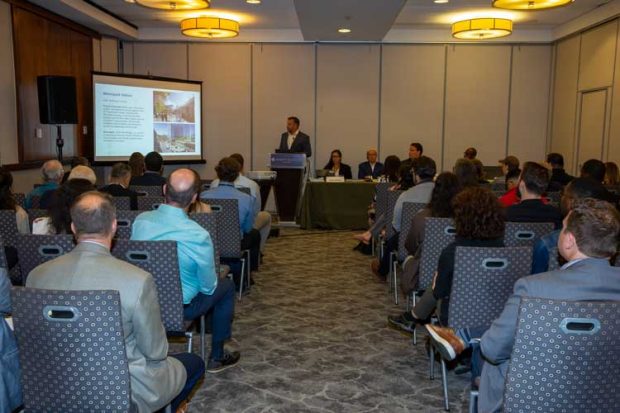
Next Stop: Transit Friendly Communities and TOD Opportunities session at the 2023 NJ Planning & Redevelopment Conference. Photo by Frank H. Conlon
Transit-friendly planning is a proactive, transit-focused approach developed by NJ Transit that is applicable to any community. Transit-friendly planning and transit-oriented development (TOD) are important components of smart growth because they allow people to live, work and play without having to rely on a car. During the second half of the 20th century, most of New Jersey’s 564 municipalities were developed and designed for the automobile, thus folks without cars are often excluded from accessing essential services. The existing 166 NJ Transit train stations provide community members with better access to employment opportunities and critical services; hence, transit-friendly planning improves transit equity and reduces carbon emissions. The second a transit rider steps off the bus or train, they become a pedestrian; thus, pedestrian-friendly development is inherently vital to TOD too. As the largest state-owned transit system in the U.S, NJ Transit has a prime opportunity to promote development, public transit ridership, and walkable communities through the TOD program in a way that takes advantage of existing infrastructure and does not consume our limited open space. Therefore, the session, “Next Stop: Transit Friendly Communities and TOD Opportunities” at the 2023 Planning and Redevelopment Conference, explored how to balance the needs of all transit users so that people of all ages and abilities can access transit facilities safely and comfortably.
Megan Massey, the Assistant Director of Transit Friendly Planning for NJ Transit, moderated the session’s panel discussion with various local government leaders. The panelists highlighted proven methods for inclusive community engagement. They included: Tim Dougherty, the Mayor of Morristown; Jason Cilento, the Mayor of Dunellen; Christopher Brown, the Director of Community Development for the City of Hoboken; and Owen Christensen, the Project Manager of Transit Oriented Development for NJ Transit. The panel sought to answer the following two essential questions: First, what is the history of TOD in your community? Second, how do you get more community buy-in for transit-friendly planning?
Massey began the session with an overview of NJ Transit’s transit friendly planning program. The program has two components: the transit friendly guide, and the implementation tools. The transit friendly guide provides recommendations for station accessibility, redevelopment, and equity, and includes planning guidance for active transportation and complete streets. Therefore, the guide helps communities plan and promote the design and development of their own TOD projects. The implementation tool provides communities with mechanisms for advancing their TOD projects. Some of the tools include community engagement strategies, non-legislative actions, land-use guidance, building regulations, and various planning approaches. Thus, the implementation tool helps turn community TOD aspirations into a reality.
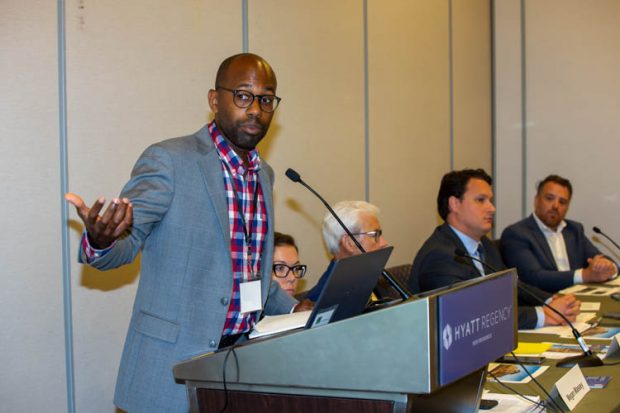
Christopher Brown, Director of Community Development, City of Hoboken, speaking during the 2023 NJ Planning & Redevelopment Conference. Photo by Frank H. Conlon
The three panelists from municipal governments highlighted components needed for the successful implementation of TOD. Morristown’s Dougherty insisted that planning must be prioritized during the process, imploring municipalities to “let the planners plan.” This means hiring independent professionals, not the elected official’s political appointees. Cilento, the Mayor of Dunellen, expressed the importance of community engagement. Public input is critical for transit-friendly planning; therefore, Dunellen conducts annual community surveys to inform the town on how community members feel about the current state and changes they wish to see going forward. Christopher Brown, of Hoboken, emphasized the importance of pedestrian design and safety. Hoboken’s zero traffic fatalities for 3 consecutive years is proof of the city’s continuous commitment to pedestrian safety. TOD cannot be successful without prioritizing pedestrians, nor is public transit accessible if it is surrounded by car-oriented development. Hence, Hoboken’s Hudson Place and Warrington Plaza are currently being redesigned to be more pedestrian-friendly like the rest of the city.
Christensen presented a few of NJ Transit’s current TOD projects. The Somerville station project is located on the Raritan Valley rail line. The development will have 512 residential units, including 356 apartments and 156 townhomes, and will provide community and open spaces, revitalize the station area, and enhance access to downtown Somerville. The Orange station project, located on the Morristown rail line, is a multi-phase residential development to build 410 apartment units in two phases. Additionally, the project will increase pedestrian safety, improve station access, and enhance community connections. The Metropark station project on the Northeast Corridor rail line will be home to a mixed-use development that includes 225 apartments, of which 20% of those apartments are affordable units. The Metropark mixed-use development will include a commercial office building and ground floor retail space. Importantly, the project makes station-area, circulation, offsite traffic mitigation, and pedestrian-friendly improvements to the area.
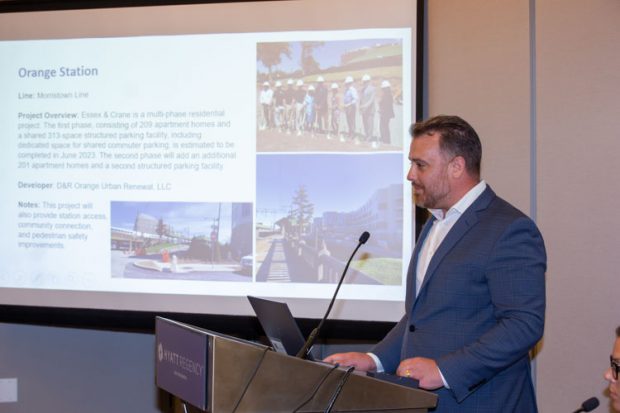
Owen Christensen, Project Manager, Transit Oriented Development, NJ TRANSIT, speaking during the 2023 NJ Planning & Redevelopment Conference. Photo by Frank H. Conlon
Transit friendly planning and TOD projects are vital for promoting equitable access throughout NJ. Folks who do not drive or own a car are unjustly excluded from many of society’s opportunities. Developing around transit centers improves the ability for community members to safely use public transportation to access critical needs, like employment opportunities and social services. The accessibility, equity, and safety benefits of TOD are evident, but they are not the only reasons for promoting transit-friendly planning. TOD is instrumental for addressing NJ Transit’s fiscal cliff as a means to build increased ridership through developing transit adjacent housing. As the need for TOD increases, demand for NJ Transit’s projects will increase too, presenting a unique opportunity for transit-oriented planning projects to improve the financial standing of NJ Transit. Therefore, TOD has the potential to benefit both municipalities and the state as a whole.
The Changing Faces of New Jersey Developers
July 18th, 2023 by Paula Figueroa-Vega

The Changing Faces of New Jersey Developers session at the 2023 NJ Planning & Redevelopment Conference. Photo by Frank H. Conlon
“Nationally, Black and Hispanic people are acutely underrepresented in real estate development…Black and Hispanic real estate developers represent less than 1% of their industry across the nation, even though Blacks make up 14% and Hispanics make up 18% of the total population. New Jersey’s affordable housing development space shows similar disparities. Between 2009 and 2023, of the 53 developers that received 9% low-income housing tax credit (LIHTC) awards in NJ, only three were Black or Hispanic-led/owned. Combined, they were awarded barely 3% of all the 9% LIHTC funding distributed in the past decade.1” These sobering statistics set the background for an engaging discussion during The Changing Faces of New Jersey Developers session at the 2023 New Jersey Planning and Redevelopment Conference, which featured four developers who have overcome challenges to shape and create their own paths in this field.
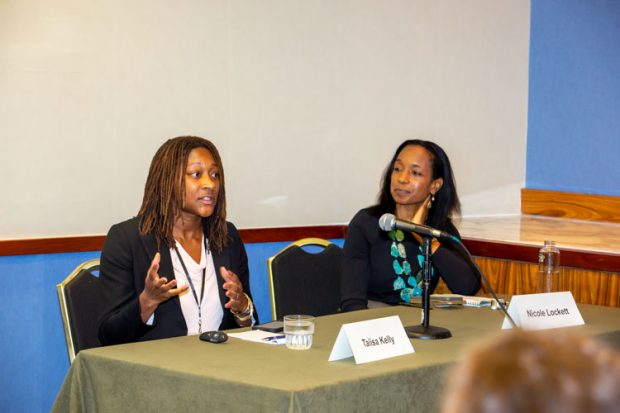
Taiisa Kelly, CEO of Monarch Housing Associates, speaking during the 2023 NJ Planning & Redevelopment Conference. Photo by Frank H. Conlon
The session was moderated by Taiisa Kelly, CEO of Monarch Housing Associates, and included affordable housing developers Adenah Bayoh, Founder and CEO of Foya Development; Eda Henries, Founder and Managing Principal of Henries & Co.; and Nicole Lockett, Managing Director of Development of Genesis Companies. They represent a rising generation of Black, Indigenous, and People of Color (BIPOC) leaders in housing and economic development who are creating a community to support each other.
The experienced developers grounded the panel in practical advice. All panelists have a successful track record of developments in New Jersey and are fighting together for individual opportunities to improve our communities: Lockett is one of those three aforementioned developers of color; Bayoh is heavily focused on affordable housing and restaurants; and Henries founded a capital advisory firm that serves small and medium-sized privately held companies. Finally, Kelly has experience in housing development, working with federal, state, and local funding sources to secure financing for special needs housing projects.

Eda Henries, Founder and Managing Principal of Henries & Co., speaking during the 2023 NJ Planning & Redevelopment Conference. Photo by Frank H. Conlon
The presenters’ journeys and reasons for becoming developers varied, reflecting numerous points of entry that were not motivated solely by business opportunities that exist in the housing market. Nicole Lockett’s journey began with volunteer work at the non-profit that her father was a board member of where she found a genuine passion toward the affordable housing industry and saw it as a way to assist people. Eda Henries, a registered broker brought into the field by Adenah Bayoh, explained that she was drawn to the financial aspects of the projects. Bayoh, on the other hand, grew up in affordable housing and views this work as an opportunity to create community spaces where people can gather. All expressed, in one way or another, that being a developer has provided an opportunity to create a new market, improve access, help people, diversify the leadership in the space, and build an ecosystem. They want to see others that look like them building more affordable housing. Lockett, who has years of experience in the business, explains that her motivation has evolved. While she still is “absolutely moved by residents” and recently opened a senior building, she comments that now, “I’m focused on growing developers.”
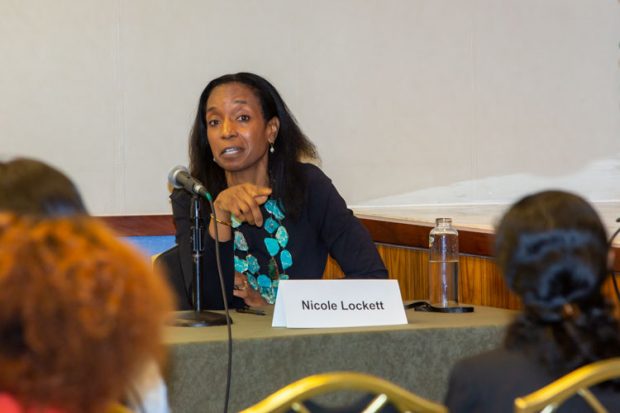
Nicole Lockett, Managing Director of Development of Genesis Companies, speaking during the 2023 NJ Planning & Redevelopment Conference. Photo by Frank H. Conlon
Lockett, who has years of experience in the business, explains that her motivation has evolved. “I’m focused on growing developers.”
Panelists discussed the role of policies and initiatives in incentivizing access to who gets to create affordable housing. “There is money in this space,” Lockett said. Laws and congressional acts support affordable housing initiatives, but the details are often hidden in lengthy bills. Advocacy is necessary to reduce the barriers embedded in regulations. The creation of rational policies depends on education and legislation. Unfortunately, some programs exclude the very people they are intended to help. Bayoh spoke about the need to focus on equity rather than equality when distributing public funds. The billion-dollar industry of affordable housing is heavily subsidized, making it crucial that tax money is distributed equitably, taking into consideration that not everyone has the same tools to compete.

Adenah Bayoh, Founder and CEO of Foya Development, speaking during the 2023 NJ Planning & Redevelopment Conference. Photo by Frank H. Conlon
One of the themes reiterated throughout the session was the importance of networks, especially for BIPOC developers. They suggested, “Get to know your mayor, the planner in your town, and know that there will always be opposition.” To effectively expand the development of affordable housing, it is crucial to be intentional. To do this, it is essential to build relationships. If you are interested in getting involved, the speakers suggest: “Start now.”
Bayoh closed the session by sharing a reflection and a call to action. She asked the packed room to imagine that instead of investing resources as the United States had done in the “war on drugs,” we directed that energy towards addressing the lack of affordable housing. Envision a “war on lack of affordable housing” and consider the possibilities of utilizing that energy to guarantee affordable housing for all.
__________________
1Data courtesy of the May 2023 Grove Impact report: Breaking the Glass Bottleneck: The Economic Potential Of Black And Hispanic Real Estate Developers And The Constraints They Face
Planning for Tomorrow, Not Today
July 18th, 2023 by Zeke Weston
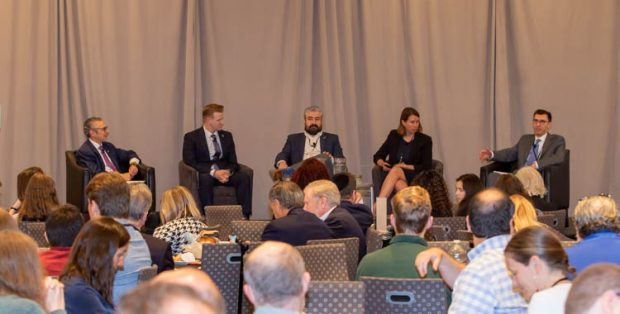
The State of Planning and Redevelopment in New Jersey plenary at the 2023 NJ Planning and Redevelopment Conference. Photo by Frank H. Conlon
“It doesn’t matter if we make every vehicle electric, and it doesn’t matter if we turn of all power plants; climate change will still get worse,” exclaimed Shawn LaTourette, the Commissioner of the New Jersey Department of Environmental Protection (NJDEP), during the 2023 Planning and Redevelopment Conference plenary, The State of Planning and Redevelopment in New Jersey, co-sponsored by New Jersey Future and the NJ Chapter of the American Planning Association. In fact, each of the four plenary speakers identified climate resilience as an eminent issue facing the state. Coordinated resilience planning, along with a comprehensive energy master plan, sustainable economic development initiatives, and an update to the State Plan were offered as prominent solutions throughout the discussion.
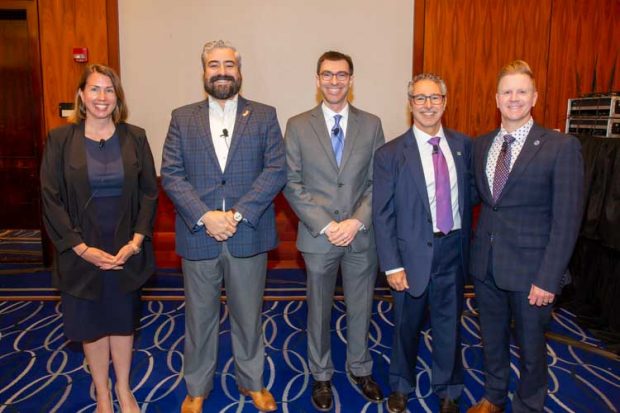
From left to right: Catherine Klinger, Executive Director, Governor’s Office of Climate Action and the Green Economy; Jorge Santos, Chief Real Estate Development Officer, New Jersey Economic Development Authority; Jeffrey Oakman, Senior Policy Advisor, Office of Governor Phil Murphy; Peter Kasabach, Executive Director, New Jersey Future; Shawn LaTourette, Commissioner, New Jersey Department of Environmental Protection. Photo by Frank H. Conlon
The plenary featured key state government executive branch officials from the Murphy Administration: Catherine Klinger, the Executive Director of the Governor’s Office of Climate Action and the Green Economy; Jeffrey Oakman, a Senior Policy Advisor in the Office of Governor Phil Murphy; Jorge Santos, the Chief Real Estate Development Officer for the New Jersey Economic Development Authority; and Shawn LaTourette, Commissioner of NJDEP. The plenary was moderated by Peter Kasabach, the Executive Director of New Jersey Future.
The purpose of NJ PACT is to update land use regulations to reflect the latest climate science to protect our state’s infrastructure from flooding.
NJDEP leads the climate change planning process in New Jersey, explained Commissioner LaTourette, and is one the region’s largest investors in climate resilience infrastructure. DEP’s statewide climate resilience strategy serves as a toolkit for agencies and municipalities to use when considering their own resilience approach. The most notable climate resilience action going forward will be a much needed update to the state’s climate and land use regulations, particularly regarding stormwater management and flood hazard rules. This regulatory reform effort is known as New Jersey Protecting Against Climate Threats (NJ PACT) and the first phase, the Inland Flood Protection (IFP) Rule, will be effective later this month. The data that informs current regulations for stormwater management and development in flood prone areas is outdated despite more frequent and intense storms and projected increases in rainfall. The purpose of NJ PACT is to update these land use regulations to reflect the latest climate science to protect our state’s infrastructure from flooding.
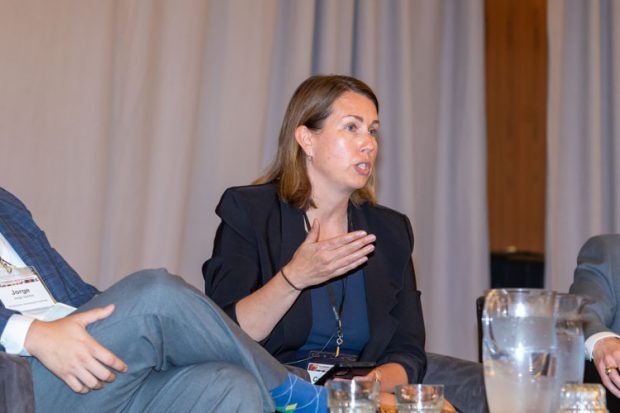
Catherine Klinger, the Executive Director of the Governor’s Office of Climate Action and the Green Economy speaking during the 2023 NJ Planning & Redevelopment Conference. Photo by Frank H. Conlon
Catherine Klinger explained how clean energy is crucial to the existence and health of New Jersey’s communities heading into the future. A comprehensive energy master plan that includes clean building guidance, climate pollution reduction strategies, and anticipated costs is vital to the state’s sustainability. The 2019 energy master plan was due to be updated in 2022, but because of numerous industry advancements, the state revised the schedule. The 2024 energy master plan will include updated data, new innovations, and anticipated costs. In addition to the statewide plan, Klinger noted that municipalities have the opportunity to develop clean energy infrastructure on their own in order to benefit their residents. Such infrastructure includes community solar arrays, public EV charging stations, thermal heat networks, and decarbonized vehicle fleets.

Jorge Santos, the Chief Real Estate Development Officer for the New Jersey Economic Development Authority, speaking during the 2023 NJ Planning & Redevelopment Conference. Photo by Frank H. Conlon
Jorge Santos detailed the significance of economic development initiatives for a sustainable New Jersey. The various economic development programs serve to improve planning and redevelopment processes and outcomes in the state. For instance, the new Stranded Assets Investment Program will help communities reposition unused assets like vacant office buildings and strip malls. This program is just one of over fifty active EDA programs, and the agency anticipates more programs to come. Through these programs, Santos explained how the EDA strives to create jobs and enhance economic activity where it is needed, while also improving diversity, equity, and inclusion.

Shawn LaTourette, Commissioner, NJDEP, speaking during the 2023 NJ Planning and Redevelopment Conference. Photo by Frank H. Conlon
The State Plan “serves as the connective tissue across state government in implementation.” – Commissioner Shawn LaTourette, NJDEP.
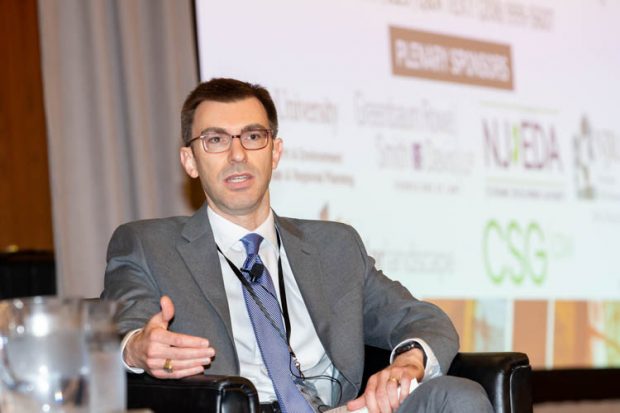
Jeffrey Oakman, a Senior Policy Advisor in the Office of Governor Phil Murphy, speaking during the 2023 NJ Planning & Redevelopment Conference. Photo by Frank H. Conlon
The panel unanimously agreed upon the need to update the State Plan. “I think we can all agree in this room that the state plan from 2001 is well overdue for an update,” Jeffrey Oakman joked while referring to the absence of climate change and equity considerations in the plan. Despite its age, the twenty-two year old document contains an abundance of important and useful information including guidance on center-based development, urban revitalization, and farmland preservation. Santos explained how the Economic Development Authority actively refers to the 2001 State Plan as a guide when developing and implementing its programs. Santos noted that updating the plan to be more relevant would be immensely helpful to the agency. For the update to be effective, Oakman suggested that it include environmental justice, economic justice, climate adaptation and resilience, and racial equity. Oakman also recognized the importance of improving the accessibility of the plan; making the document accessible online with user-friendly tools is vital for helping agencies and localities implement the plan’s priorities. The State Plan “serves as the connective tissue across state government in implementation,” stated LaTourette; therefore, ensuring that folks can easily engage with it and understand it is a critical component of the update process.
The importance of sensible and equitable planning and redevelopment is directly correlated with fostering healthy and resilient communities. For New Jersey, this means developing coordinated climate resilience planning, a comprehensive energy master plan, sustainable economic development initiatives, and a much needed update to the State Plan. The plenary, The State of Planning and Redevelopment in New Jersey, concluded with a multitude of questions from the audience. PRC attendees were eager for the panel to hear their questions, and the panelists were ready for whatever the audience threw at them. The energetic ending to a productive session, ignited synergy for further discussions on planning issues in New Jersey. For further reading on the importance of an updated state plan for NJ, please read “Launching the Next State Plan”, which explored this topic at a breakout session at the conference.
Hinchliffe Stadium Opens New Opportunities for Paterson while Reconnecting to its Past
July 18th, 2023 by Michael Atkins
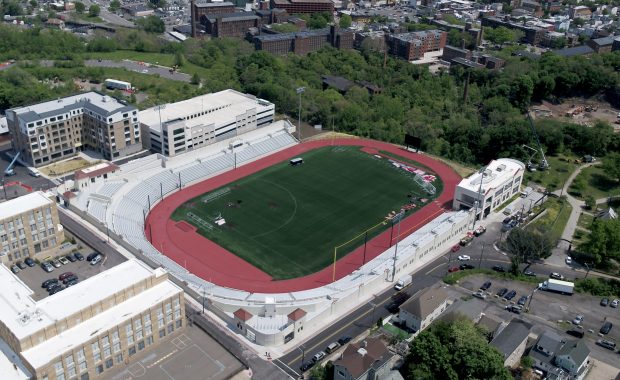
The restoration of Hinchliffe Stadium in Paterson, NJ.
While New York City boasts the “House that Ruth Built,” and Cooperstown and Kansas City host hall of fames, New Jersey’s role in the history of baseball, and in particular, NJ’s open exhibition of Black baseball during segregation is often overlooked. Hinchliffe Stadium was once a bustling hub for Black baseball, drawing fans from across the region to Paterson, NJ to see the best players of the day. After years being unoccupied, a new and exciting redevelopment project in Paterson — the largest historic preservation project in NJ — that is the talk of the town and state, providing an unmatched example for blending outdoor activities, historical representation, and contemporary urban needs in one mixed-use project.
A session at the Planning and Redevelopment Conference dedicated to chronicling the success of the Hinchliffe redevelopment project titled, “Thrills, Skill, & Spills: Lessons Learned from the Hinchliffe Stadium/Paterson Redevelopment Project” convening public and private perspectives on this stellar project that has energized local and statewide communities. Panelists included Baye Adofo-Wilson, Redevelopment Counsel, Post Polak; Joseph Portelli, Senior VP of Development, RPM Development Group; Michael Powell, Director of Economic Development, City of Paterson; and George Wheatle Williams, Founding Principal, Nishuane Group, LLC; and was moderated by Anne Babineau, Shareholder, Wilentz, Goldman & Spitzer, P.A.
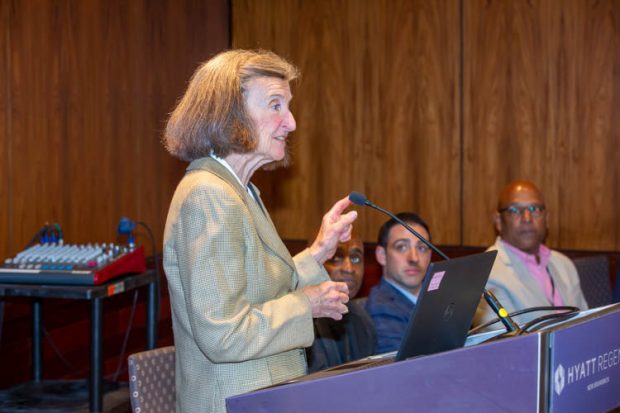
Anne Babineau, Shareholder, Wilentz, Goldman & Spitzer, P.A., speaking during Thrills, Skill, & Spills: Lessons Learned from the Hinchliffe Stadium/Paterson Redevelopment Project session at the 2023 NJ Planning & Redevelopment Conference. Photo by Frank H. Conlon
In summary, the project provides the following amenities: revitalization of the stadium to include recreational facilities for local school, a museum dedicated to Negro League Baseball, development of 75 new affordable units for seniors, and a 315 space parking facility. Joseph Portelli, who brought with him a presentation featuring photographs, renderings, and a drone film overview of the site, noted the 800-seat stadium will also host a restaurant and a daycare.
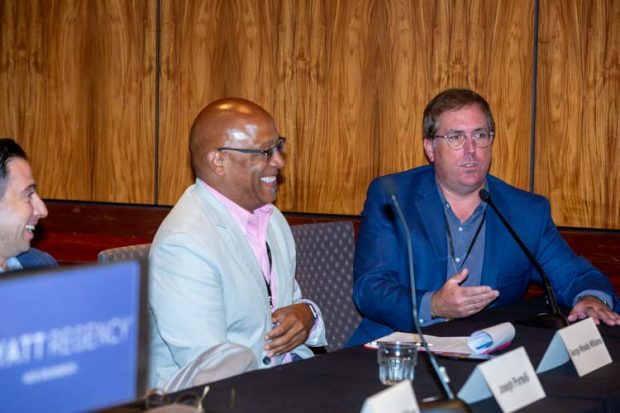
Michael Powell, Director of Economic Development, City of Paterson, speaking during the 2023 NJ Planning & Redevelopment Conference. From left to right: Joseph Portelli, Senior VP of Development, RPM Development Group; George Wheatle Williams, Founding Principal, Nishuane Group, LLC; Michael Powell, Director of Economic Development, City of Paterson. Photo by Frank H. Conlon
“The point is difficult things are difficult to do, but it takes a good team to get it done.” -Michael Powell, City of Paterson
The assembled panelists, all of whom worked closely on various aspects of the redevelopment project, shared how blending and balancing community needs with funding streams made it possible. Each component of the project had a funding source, and a discreet use. While it is in total a mixed use project, each “use” had a dedicated funding stream including, but not limited to, historic and new market tax credits, soft subsidies, and Covid recovery funds.
This varied approach in securing funding mirrored the complexities of stakeholders in the project. Hinchliffe Stadium is a city property owned by the Paterson School Board and is a National Historic Landmark site, with each layer posing challenges. “In negotiating with the school board, your threshold for community partnerships is a real challenge. You need to at times bite the bullet for the common good,” noted Adofo-Wilson. With the school district serving as the primary tenant for 180 days of the year, the project team had to continually persuade external partners of the ultimate positive impact the project would have on the city and community.
“Paterson is the third largest city in New Jersey. Cities needed a certain amount of push. Paterson is [oriented] around the Falls, and densely populated [with] 168,000 people,” explained Baye Adofo-Wilson. He asks, “How do you maximize the people, how do you maximize the historic assets, and how do you think about towns that are fundamentally oriented differently than ‘How fast can you get me to New York or Philadelphia?’”
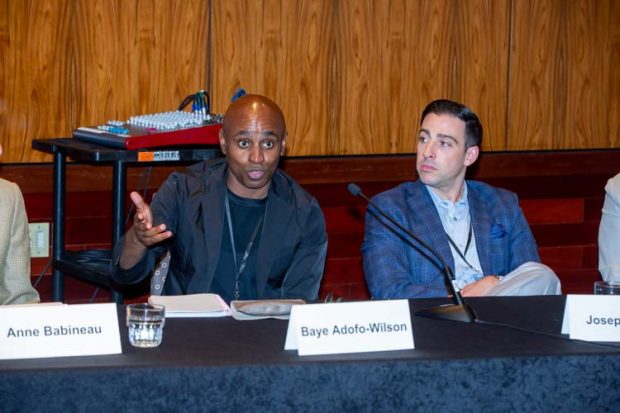
Baye Adofo-Wilson, Redevelopment Counsel, Post Polak, speaking during the 2023 NJ Planning & Redevelopment Conference. From left to right: Baye Adofo-Wilson, Redevelopment Counsel, Post Polak; Joseph Portelli, Senior VP of Development, RPM Development Group. Photo by Frank H. Conlon
Global, national, and statewide trends all influenced the realization of this project in the heart of Paterson. As Michael Powell shared, “The realities of dealing with this during Covid was that what made this project possible is because it was outdoors, and because the museum examined race and class history in America. To do this around a narrative that makes Paterson interesting as a minority-majority city, is that it hasn’t gotten its fair shake.” Adofo-Wilson added to this, “NJ has a great policy that mandates Black History education in NJ. This is a new policy and a new opportunity. We have created a regional and statewide attraction to bring NJ students to a Black history site.”
Wheatle Williams, noted that the story begins much earlier than 2020, or the current elected administration taking office in 2018. It all starts with thoughtful planning. “I would like to acknowledge Paterson’s role and give credit to the work done on the planning and public side. Their 2003 Master Plan spoke to using redevelopment planning in Paterson strategically and intentionally. When the Master Plan was updated in 2014, it again focused on redevelopment plans for Paterson, including Hinchliffe Stadium.”
Adofo-Wilson reflected, “Everybody feels like they own the stadium. We had an 80 something couple who were a cheerleader and running back with memories from the stadium stretching back to the 1950s. And we had a number of people involved in this project who went beyond their professional obligations over and over again out of dedication to making this project a reality.” Powell concurred, “The point is difficult things are difficult to do, but it takes a good team to get it done.” With Hinchliffe Stadium now once again playing host to baseball, Paterson has many fans locally and statewide cheering it on from the stands.











